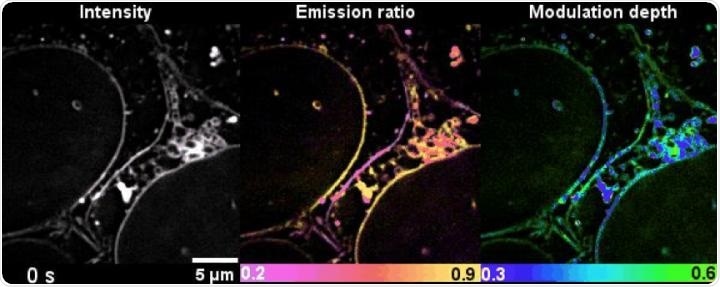The potential to “see” the inner mechanisms of structures, or organelles, inside the cells, in real-time, provides the promise of developments in the diagnosis and treatment of various diseases.

Time-lapse high-dimensional super-resolution imaging of the late-stage division of two U2-OS cells. Image Credit: From Nature Communications Karl Zhanghao et al.
While organelle dynamics are known to fuel the self-efficient micro-realm of cells, existing super-resolution microscopy methods used to monitor such interplays have certain limitations.
Now, a next-generation method called Spectrum and Polarization Optical Tomography, or SPOT for short, is providing researchers with a “street view” of the major lipid membranes that surround the organelles and by so doing paves the way to explore the advanced world of lipid dynamics.
According to scientists, it is a major advancement, which builds on previous studies on super-resolution polarization microscopy.
Published in the Nature Communications journal, the study was designed through an association between the University of Technology Sydney-Southern University of Science and Technology (UTS-SUStech) Joint Research Centre for Biomedical Materials & Devices, and Peking University.
Dr. Karl Zhangao, the study’s lead author who works at UTS-SUSTech Joint Research Centre, stated that lipid membranes enclose a majority of the organelles and play a crucial role.
Their shape, composition and phase synergistically regulate biophysical membrane properties, membrane protein function and lipid-protein interactions. However it is challenging to observe such a level of complexity due to their similar chemical composition.”
Dr Karl Zhangao, Study Lead Author, UTS-SUSTech Joint Research Centre
The SPOT technique uses only a single dye that collectively stains the lipid membranes, and can concurrently reveal the polarity, morphology, and phase of the lipid membrane by quantifying the spectrum, intensity, and polarization, respectively.
Using lipophilic probes, the researchers effectively uncovered over 10 types of organelles at the same time, and also their advanced lipid dynamics.
With the help of the novel imaging platform established at SUStech, scientists visualized the multi-organelle interactive functions of cell division—that is, lipid dynamics during the separation of plasma membranes, the formation of tunneling nanotubules, and the dissociation of mitochondrial cristae.
This is the first time researchers have been able to quantitatively study the lipid heterogeneity inside subcellular organelles.”
Dayong Jin, Study Senior Author and Professor, UTS-SUStech Joint Research Centre
Professor Jin is also the Director of UTS-SUStech Joint Research Centre and the Director of UTS Institute for Biomedical Materials and Devices.
“This is a very powerful tool for super-resolution imaging the inner working of each single cells, that will advance our knowledge in understanding how cells function, diagnose when a ‘factory’ or transportation doesn't work properly within the cell, and monitor the progression of the disease. With such information it isn't too big a leap to identify pathways for potential drug treatments, as well as examine their efficacy right on the SPOT,” concluded Professor Jin.
Source:
Journal reference:
Zhanghao, K., et al. (2020) High-dimensional super-resolution imaging reveals heterogeneity and dynamics of subcellular lipid membranes. Nature Communications. doi.org/10.1038/s41467-020-19747-0.